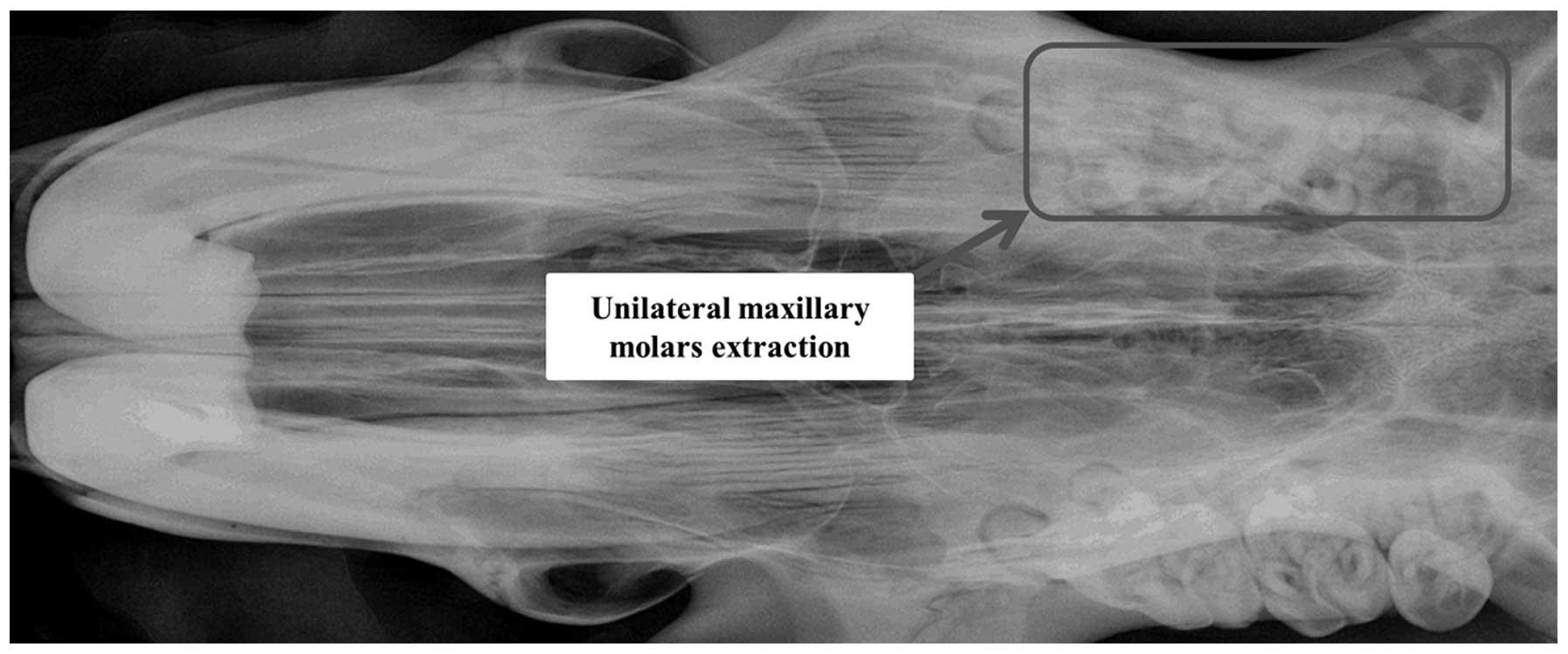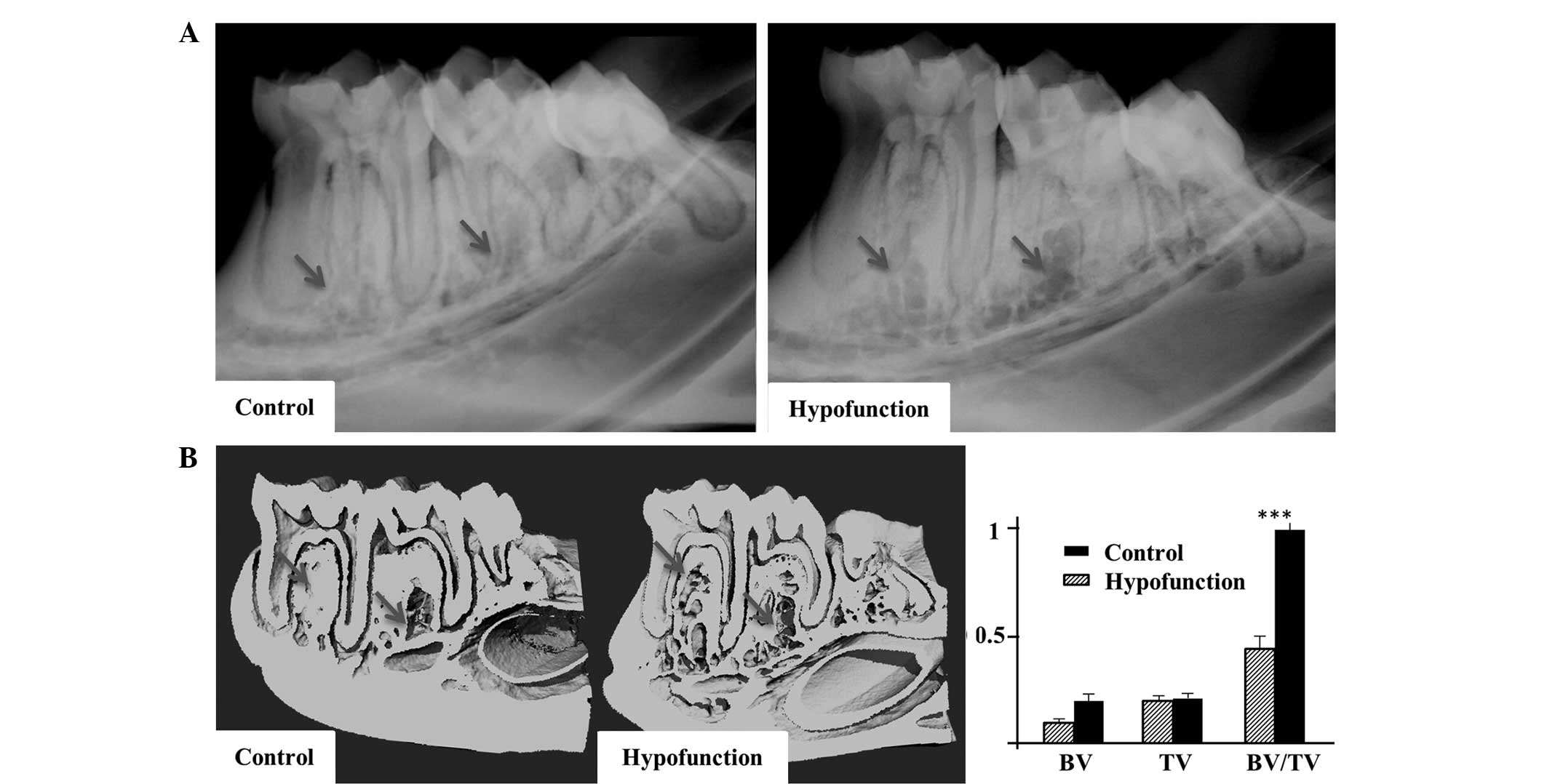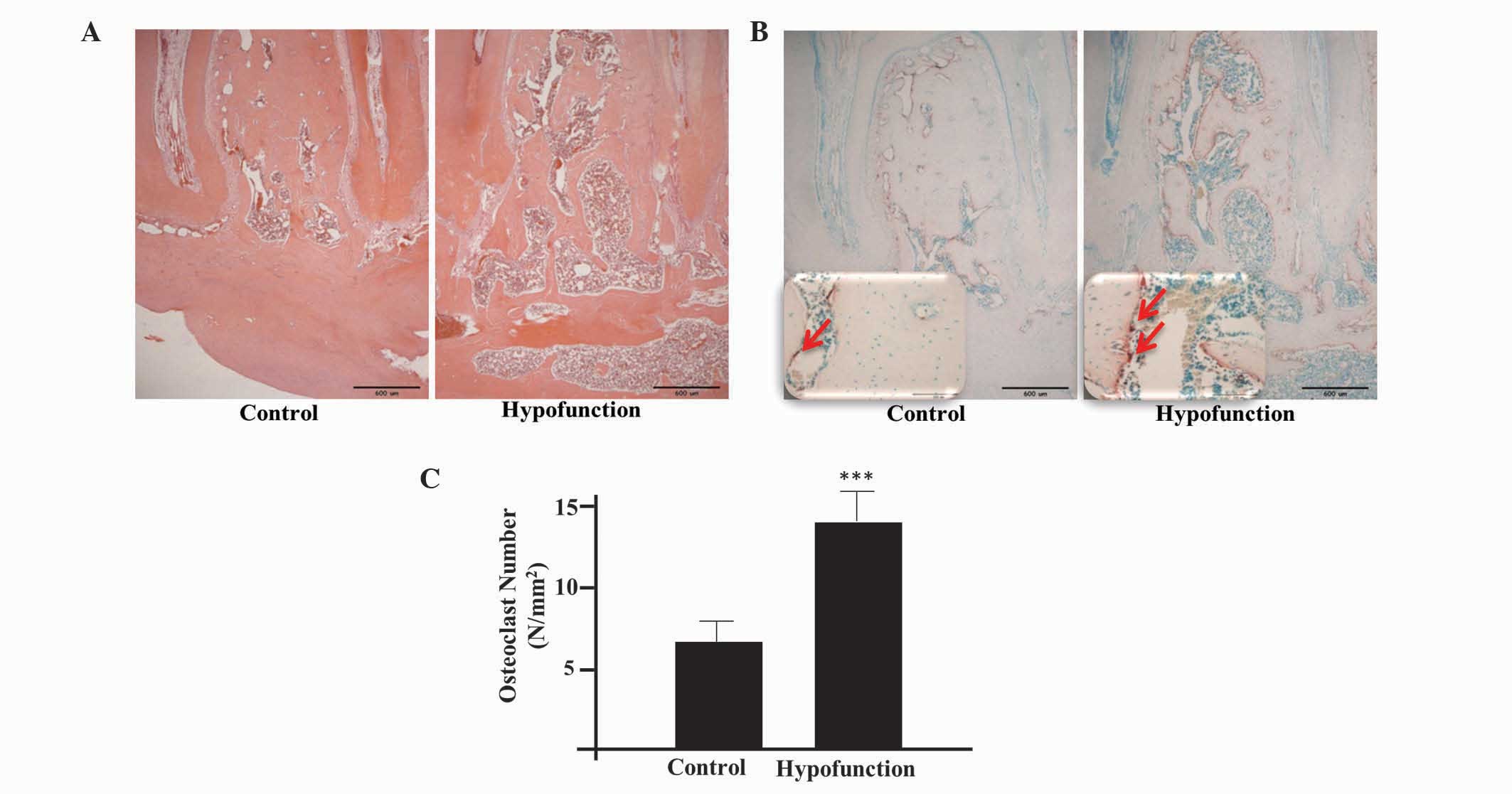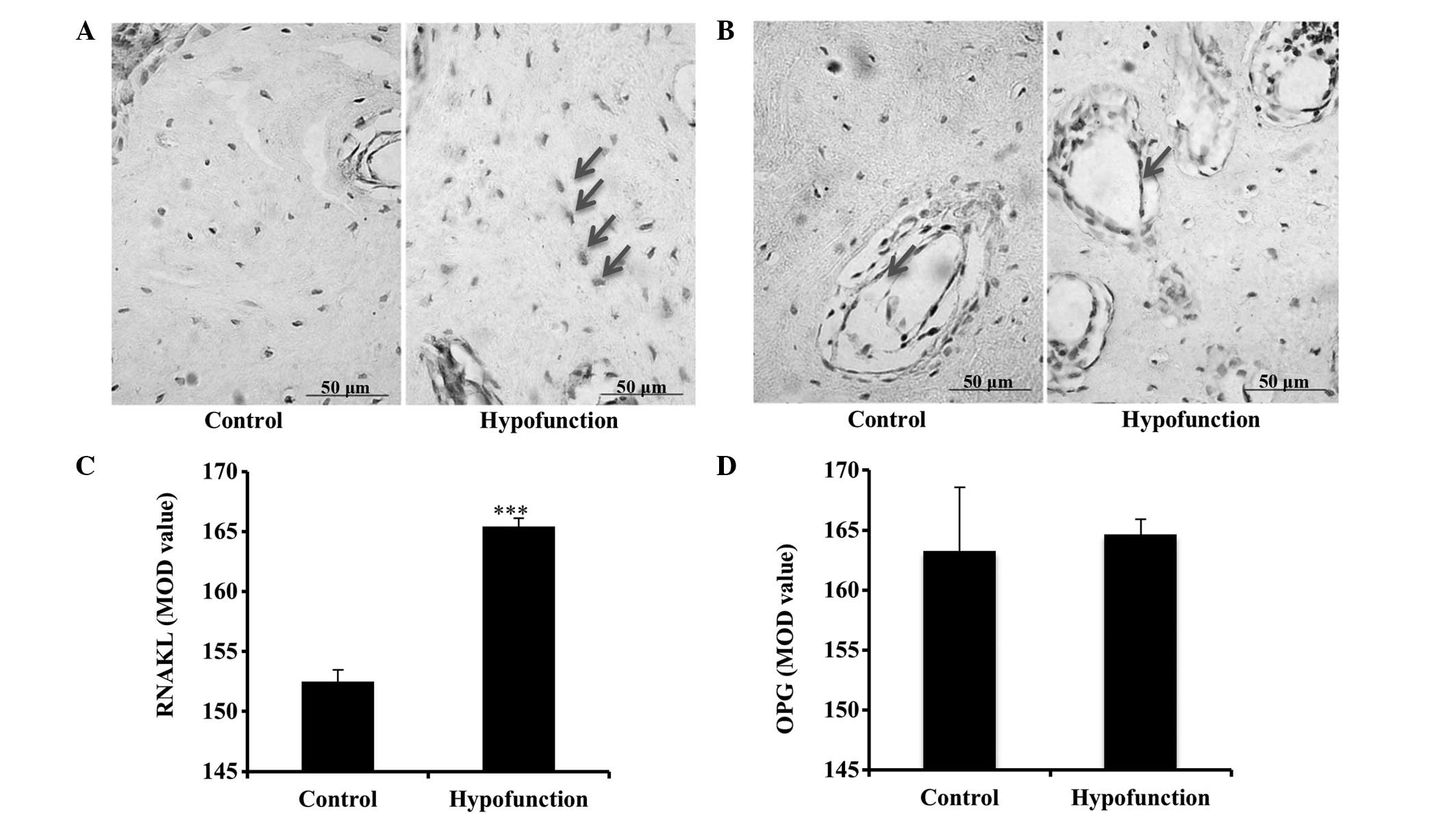|
1
|
Recent advances in oral health. Report of
a WHO Expert Committee. World Health Organ Tech Rep Ser. 826:1–37.
1992.PubMed/NCBI
|
|
2
|
Müller F, Naharro M and Carlsson GE: What
are the prevalence and incidence of tooth loss in the adult and
elderly population in Europe? Clin Oral Implants Res. 18(Suppl 3):
S2–S14. 2007. View Article : Google Scholar
|
|
3
|
Harada S and Rodan G: Control of
osteoblast function and regulation of bone mass. Nature.
423:349–355. 2003. View Article : Google Scholar : PubMed/NCBI
|
|
4
|
Jacobs CR, Temiyasathit S and Castillo AB:
Osteocyte mechanobiology and pericellular mechanics. Annu Rev
Biomed Eng. 12:369–400. 2010. View Article : Google Scholar : PubMed/NCBI
|
|
5
|
Bikle DD and Halloran BP: The response of
bone to unloading. J Bone Miner Metab. 17:233–244. 1999. View Article : Google Scholar : PubMed/NCBI
|
|
6
|
Shimomoto Y, Chung CJ, Iwasaki HY,
Muramoto T and Soma K: Effects of occlusal stimuli on alveolar/jaw
bone formation. J Dent Res. 86:47–51. 2007. View Article : Google Scholar : PubMed/NCBI
|
|
7
|
von Wowern N, Hjørting-Hansen E and
Stoltze K: Changes in bone mass in rat mandibles after tooth
extraction. Int J Oral Surg. 8:229–233. 1979. View Article : Google Scholar : PubMed/NCBI
|
|
8
|
Ejiri S, Toyooka E, Tanaka M, Anwar RB and
Kohno S: Histological and histomorphometrical changes in rat
alveolar bone following antagonistic tooth extraction and/or
ovariectomy. Arch Oral Biol. 51:941–950. 2006. View Article : Google Scholar : PubMed/NCBI
|
|
9
|
Kuroda S, Mukohyama H, Kondo H, Aoki K,
Ohya K, Ohyama T and Kasugai S: Bone mineral density of the
mandible in ovariectomized rats: Analyses using dual energy X-ray
absorptiometry and peripheral quantitative computed tomography.
Oral Dis. 9:24–28. 2003. View Article : Google Scholar : PubMed/NCBI
|
|
10
|
Elovic RP, Hipp JA and Hayes WC: Maxillary
molar extraction decreases stiffness of the mandible in
ovariectomized rats. J Dent Res. 73:1735–1741. 1994.PubMed/NCBI
|
|
11
|
Elovic RP, Hipp JA and Hayes WC: Maxillary
molar extraction causes increased bone loss in the mandible of
ovariectomized rats. J Bone Miner Res. 10:1087–1093. 1995.
View Article : Google Scholar : PubMed/NCBI
|
|
12
|
Glass DA II and Karsenty G: Molecular
bases of the regulation of bone remodeling by the canonical Wnt
signaling pathway. Curr Top Dev Biol. 73:43–84. 2006. View Article : Google Scholar : PubMed/NCBI
|
|
13
|
Tatsumi S, Ishii K, Amizuka N, Li M,
Kobayashi T, Kohno K, Ito M, Takeshita S and Ikeda K: Targeted
ablation of osteocytes induces osteoporosis with defective
mechanotransduction. Cell Metab. 5:464–475. 2007. View Article : Google Scholar : PubMed/NCBI
|
|
14
|
Weidauer SE, Schmieder P, Beerbaum M,
Schmitz W, Oschkinat H and Mueller TD: NMR structure of the Wnt
modulator protein sclerostin. Biochem Biophys Res Commun.
380:160–165. 2009. View Article : Google Scholar : PubMed/NCBI
|
|
15
|
Poole KE, van Bezooijen RL, Loveridge N,
Hamersma H, Papapoulos SE, Löwik CW and Reeve J: Sclerostin is a
delayed secreted product of osteocytes that inhibits bone
formation. FASEB J. 19:1842–1844. 2005.PubMed/NCBI
|
|
16
|
Bonewald LF and Johnson M: Osteocytes,
mechanosensing and Wnt signaling. Bone. 42:606–615. 2008.
View Article : Google Scholar : PubMed/NCBI
|
|
17
|
Galli C, Passeri G and Macaluso GM:
Osteocytes and WNT: The mechanical control of bone formation. J
Dent Res. 89:331–343. 2010. View Article : Google Scholar : PubMed/NCBI
|
|
18
|
Paszty C, Turner CH and Robinson MK:
Sclerostin: A gem from the genome leads to bone-building
antibodies. J Bone Miner Res. 25:1897–1904. 2010. View Article : Google Scholar : PubMed/NCBI
|
|
19
|
Wijenayaka AR, Kogawa M, Lim HP, Bonewald
LF, Findlay DM and Atkins GJ: Sclerostin stimulates osteocyte
support of osteoclast activity by a RANKL-dependent pathway. PLoS
One. 6:e259002011. View Article : Google Scholar : PubMed/NCBI
|
|
20
|
Lin C, Jiang X, Dai Z, Guo X, Weng T, Wang
J, Li Y, Feng G, Gao X and He L: Sclerostin mediates bone response
to mechanical unloading through antagonizing Wnt/beta-catenin
signaling. J Bone Miner Res. 24:1651–1661. 2009. View Article : Google Scholar : PubMed/NCBI
|
|
21
|
Naveh GR, Lev-Tov CN, Zaslansky P, Shahar
R and Weiner S: Tooth-PDL-bone complex: Response to compressive
loads encountered during mastication-a review. Arch Oral Biol.
57:1575–1584. 2012. View Article : Google Scholar : PubMed/NCBI
|
|
22
|
Gerritsen AE, Allen PF, Witter DJ,
Bronkhorst EM and Creugers NH: Tooth loss and oral health-related
quality of life: A systematic review and meta-analysis. Health Qual
Life Outcomes. 8:1262010. View Article : Google Scholar : PubMed/NCBI
|
|
23
|
Schropp L, Wenzel A, Kostopoulos L and
Karring T: Bone healing and soft tissue contour changes following
single-tooth extraction: A clinical and radiographic 12-month
prospective study. Int J Periodontics Restorative Dent. 23:313–323.
2003.PubMed/NCBI
|
|
24
|
Tan WL, Wong TL, Wong MC and Lang NP: A
systematic review of post-extractional alveolar hard and soft
tissue dimensional changes in humans. Clin Oral Implants Res.
23(Suppl 5): S1–S21. 2012. View Article : Google Scholar
|
|
25
|
Sennerby L, Carsson GE, Bergman B and
Warfvinge J: Mandibular bone resorption in patients treated with
tissue-integrated prostheses and in complete-denture wearers. Acta
Odontol Scand. 46:135–140. 1988. View Article : Google Scholar : PubMed/NCBI
|
|
26
|
Bodic F, Hamel L, Lerouxel E, Baslé MF and
Chappard D: Bone loss and teeth. Joint Bone Spine. 72:215–221.
2005. View Article : Google Scholar : PubMed/NCBI
|
|
27
|
Klein-Nulend J, Bakker AD, Bacabac RG,
Vatsa A and Weinbaum S: Mechanosensation and transduction in
osteocytes. Bone. 54:182–190. 2013. View Article : Google Scholar : PubMed/NCBI
|
|
28
|
Bonewald LF: The amazing osteocyte. J Bone
Miner Res. 26:229–238. 2011. View
Article : Google Scholar : PubMed/NCBI
|
|
29
|
Bonewald LF: Mechanosensation and
transduction in osteocytes. Bonekey Osteovision. 3:7–15. 2006.
View Article : Google Scholar : PubMed/NCBI
|
|
30
|
Robling AG, Niziolek PJ, Baldridge LA,
Condon KW, Allen MR, Alam I, Mantila SM, Gluhak-Heinrich J, Bellido
TM, Harris SE and Turner CH: Mechanical stimulation of bone in vivo
reduces osteocyte expression of sost/sclerostin. J Biol Chem.
283:5866–5875. 2008. View Article : Google Scholar : PubMed/NCBI
|
|
31
|
Ellies DL, Viviano B, McCarthy J, Rey JP,
Itasaki N, Saunders S and Krumlauf R: Bone density ligand,
sclerostin, directly interacts with LRP5 but not LRP5G171V to
modulate Wnt activity. J Bone Miner Res. 21:1738–1749. 2006.
View Article : Google Scholar : PubMed/NCBI
|
|
32
|
Tu X, Rhee Y, Condon KW, Bivi N, Allen MR,
Dwyer D, Stolina M, Turner CH, Robling AG, Plotkin LI and Bellido
T: Sost downregulation and local Wnt signaling are required for the
osteogenic response to mechanical loading. Bone. 50:209–217. 2012.
View Article : Google Scholar : PubMed/NCBI
|
|
33
|
Lewiecki EM: Role of sclerostin in bone
and cartilage and its potential as a therapeutic target in bone
diseases. Ther Adv Musculoskelet Dis. 6:48–57. 2014. View Article : Google Scholar : PubMed/NCBI
|
|
34
|
Virdi AS, Irish J, Sena K, Liu M, Ke HZ,
McNulty MA and Sumner DR: Sclerostin antibody treatment improves
implant fixation in a model of severe osteoporosis. J Bone Joint
Surg Am. 97:133–40. 2015. View Article : Google Scholar : PubMed/NCBI
|
|
35
|
Moe SM, Chen NX, Newman CL, Organ JM,
Kneissel M, Kramer I, Gattone VH 2nd and Allen MR: Anti-sclerostin
antibody treatment in a rat model of progressive renal
osteodystrophy. J Bone Miner Res. 30:499–509. 2015. View Article : Google Scholar : PubMed/NCBI
|
|
36
|
Costa AG, Bilezikian JP and Lewiecki EM:
The potential use of antisclerostin therapy in chronic kidney
disease-mineral and bone disorder. Curr Opin Nephrol Hypertens.
24:324–329. 2015.PubMed/NCBI
|
|
37
|
Tanaka Y, Nakayamada S and Okada Y:
Osteoblasts and osteoclasts in bone remodeling and inflammation.
Curr Drug Targets Inflamm Allergy. 4:325–328. 2005. View Article : Google Scholar : PubMed/NCBI
|
|
38
|
Nakashima T, Hayashi M, Fukunaga T, Kurata
K, Oh-Hora M, Feng JQ, Bonewald LF, Kodama T, Wutz A, Wagner EF, et
al: Evidence for osteocyte regulation of bone homeostasis through
RANKL expression. Nat Med. 17:1231–1234. 2011. View Article : Google Scholar : PubMed/NCBI
|
|
39
|
Semënov M, Tamai K and He X: SOST is a
ligand for LRP5/LRP6 and a Wnt signaling inhibitor. J Biol Chem.
280:26770–26775. 2005. View Article : Google Scholar : PubMed/NCBI
|
|
40
|
Li X, Zhang Y, Kang H, Liu W, Liu P, Zhang
J, Harris SE and Wu D: Sclerostin binds to LRP5/6 and antagonizes
canonical Wnt signaling. J Biol Chem. 280:19883–19887. 2005.
View Article : Google Scholar : PubMed/NCBI
|
|
41
|
Muramoto T, Takano Y and Soma K:
Time-related changes in periodontal mechanoreceptors in rat molars
after the loss of occlusal stimuli. Arch Histol Cytol. 63:369–380.
2000. View Article : Google Scholar : PubMed/NCBI
|
|
42
|
Lekic P and McCulloch CA: Periodontal
ligament cell population: The central role of fibroblasts in
creating a unique tissue. Anat Rec. 245:327–341. 1996. View Article : Google Scholar : PubMed/NCBI
|
|
43
|
Ke HZ, Richards WG, Li X and Ominsky MS:
Sclerostin and dickkopf-1 as therapeutic targets in bone diseases.
Endocr Rev. 33:747–783. 2012. View Article : Google Scholar : PubMed/NCBI
|
|
44
|
Shahnazari M, Wronski T, Chu V, Williams
A, Leeper A, Stolina M, Ke HZ and Halloran B: Early response of
bone marrow osteoprogenitors to skeletal unloading and sclerostin
antibody. Calcif Tissue Int. 91:50–58. 2012. View Article : Google Scholar : PubMed/NCBI
|
|
45
|
Spatz JM, Ellman R, Cloutier AM, Louis L,
van Vliet M, Suva LJ, Dwyer D, Stolina M, Ke HZ and Bouxsein ML:
Sclerostin antibody inhibits skeletal deterioration due to reduced
mechanical loading. J Bone Miner Res. 28:865–874. 2013. View Article : Google Scholar : PubMed/NCBI
|














